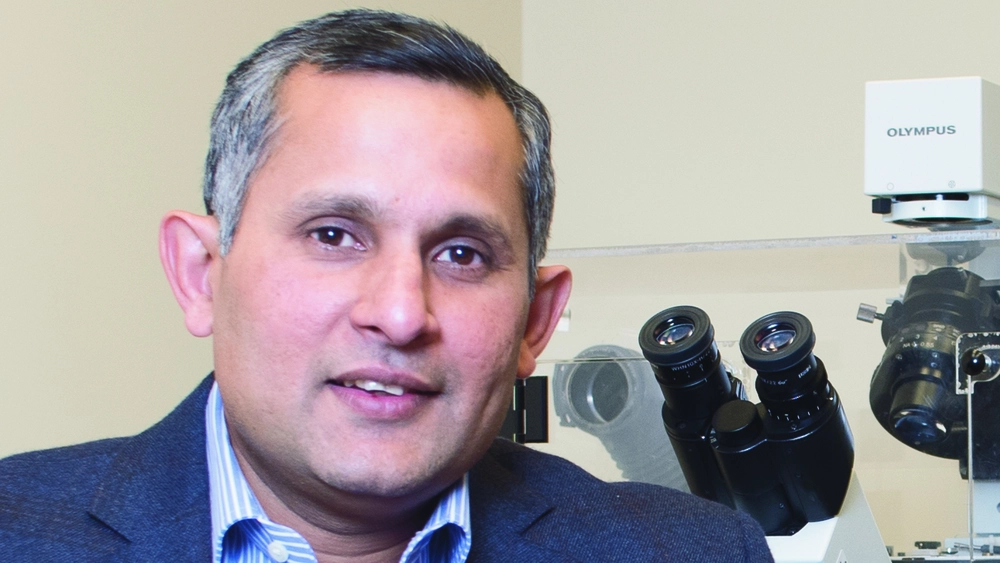
Kannanganattu V. Prasanth was a graduate student in India a little over 20 years ago when he was told that no one was interested in long non-coding RNAs (lncRNAs). Some of the professors also lamented that there was little future for studying the function of the so-called “unimportant and junk RNAs.”
But he wasn’t discouraged.
“Maybe it was my young age, but I wanted to do something that was outside the box,” said Prasanth, a University of Illinois MCB professor of cell and developmental biology. Today, not only is he still doing research on lncRNAs, but many other people have jumped on the bandwagon.
“The field of lncRNA is really hot,” he said. “Everyone wants to study it,” with more than 2,700 papers published on the topic in 2017 alone.
Prasanth’s lab published several papers on a particular lncRNA called MALAT1, with significant findings showing an important link between cancer and MALAT1. They found that when MALAT1 is overexpressed in breast cells, the cells form tumors. Conversely, when it is depleted in breast cancer cells, the cells lose the properties necessary to produce tumors.
Prasanth also gives credit to the lab of his wife and fellow MCB researcher, Supriya G. Prasanth, as they collaborate on this and other projects in both of their labs. Supriya’s lab is pursuing research on cell organization that has cancer ramifications as well.
David Spector, Prasanth’s mentor from his postdoctoral years at Cold Spring Harbor Laboratory in New York, also published a paper in 2016 showing the connection between high levels of MALAT1 and breast cancer. Spector’s lab focuses more on drug development to battle breast cancer, making small molecules to inhibit MALAT1, while Prasanth’s lab, in contrast, concentrates on basic biology—How exactly does MALAT1 regulate the expression of genes in the genesis of tumors?
“MALAT1 is also present in normal cells, operating under normal conditions, so cancer cells might be exploiting this to their own benefit. That may be why cancer cells are addicted to high levels of MALAT1,” said Prasanth, who has been an American Cancer Society Research Scholar since 2011.
His lab has shown that MALAT1 is found to enrich in nuclear speckles, a domain of the cell nucleus. He also discovered that it plays an important role in regulating the activity of a family of pre-mRNA splicing factors known as SR proteins.
A human cell has about 2,500-3,000 copies of MALAT1 in its nucleus, but a cancer cell shows a two to threefold increase in the copy number of MALAT1, “and that completely changes the dynamics,” he says. With so many copies at work, they control more SR proteins in the cell than normal, and the SR proteins, in turn, splice pre-mRNAs of genes that have the potential to cause cancer.
“It’s like a puzzle,” Prasanth said. “MALAT1 interacts with the SR protein here, and you have the splicing of oncogenic pre-mRNAs there. We’re now trying to identify those oncogenic genes whose splicing is regulated by the MALAT1-SR protein axis.”
MALAT1 seems to be involved in all subtypes of breast cancer, he adds, but their lab is focused on triple negative breast cancer (TNBC), which is one of the most aggressive forms of breast cancer. Presently, the only option to treat TNBC is through chemotherapy, but the disease becomes resistant to chemo over time, so treatments are limited right now. That’s why research to understand the biology of molecules such as MALAT1 in TNBC is crucial in order to develop next-generation drugs.
LncRNA, such as MALAT1, is longer than 200 nucleotides, and it was once considered unimportant, Prasanth says, because biology was a protein-centric world 20 years ago. The central dogma of molecular biology says that genetic information flows from DNA to RNA to make proteins, which do all of the heavy lifting in cells. LncRNA upended this dogma because it does not code for proteins and yet it still performs numerous vital functions in a cell.
Back in 1995, researchers were aware of only a few lncRNAs, but today they have identified over 20,000, and they have pinpointed the function of several hundred of them.
Prasanth started his work on MALAT1 in 2005 while in Spector’s lab at Cold Spring Harbor, but with his mentor’s blessing he brought this research to the U of I when he and his wife came to Urbana as MCB professors in 2007. Today, Prasanth and Supriya have labs side-byside in the Chemical and Life Sciences Building, and their students work together as one unit, even though each lab pursues its own unique projects. As Supriya and Prasanth continue to collaborate extensively on several ongoing research projects, they also challenge each other.
“That’s the way science works,” Prasanth poined out. “You always need to be challenged.”
